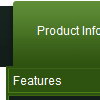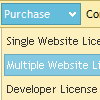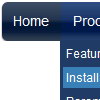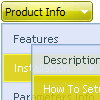Recent Questions
Q: Do you have a product that serves as a cascading drop down menu where you can override the width of the display?
A: You can use "smart scrolling" feature in this case for the Deluxe Menu.
To disable/enable the "smart scrolling" for the main items and submenus use the following javascript scrolling menu parameters:
var smSmartScroll = 1;
var topSmartScroll = 1; (works if var menuWidth isn't empty)
You can also specify height and width for each separate submenu using the following menu parameters:
var smWidth = "100px";
var smHeight = "300px";
Q: Hi I have a accessible dhtml menu item which has a word wrap on it. The word wrap it auto so instead of saying the following
Sickline Call
123456789
It says
Sickline Call 123
456789
I need to put either spaces in the title to level it out or a carage return
A: You can use any html code within accessible dhtml menu Items, for example:
var menuItems = [
["Home","testlink.html", "", "", "", "", "", "", "", ],
["Sickline Call<br>123456789","", "default.files/icon1.gif", "default.files/icon1o.gif", "", "", "", "", "", ],
Q: I am using deluxe menus and have a problem with images not downloading when the page loads. Is there a way to instruct the menus to preload the images instead of waiting until a person mouse overs the basic drop down menu for the first time?
I am using images that are called via stylesheet.
A: Please try to add the following basic drop down menu parameter:
var dm_writeAll = 1;
Q: What is wrong here ???
["|<div OnMouseOver=alert('This is a test');>ABMELDEN</div>", "Logout.asp", "icon2_s.gif","icon2_s.gif","","Abmelden",,"3"],
A: You should write:
["|<div OnMouseOver='alert(\"This is a test\");'>ABMELDEN</div>","Logout.asp", "icon2_s.gif","icon2_s.gif","","Abmelden",,"3"],










